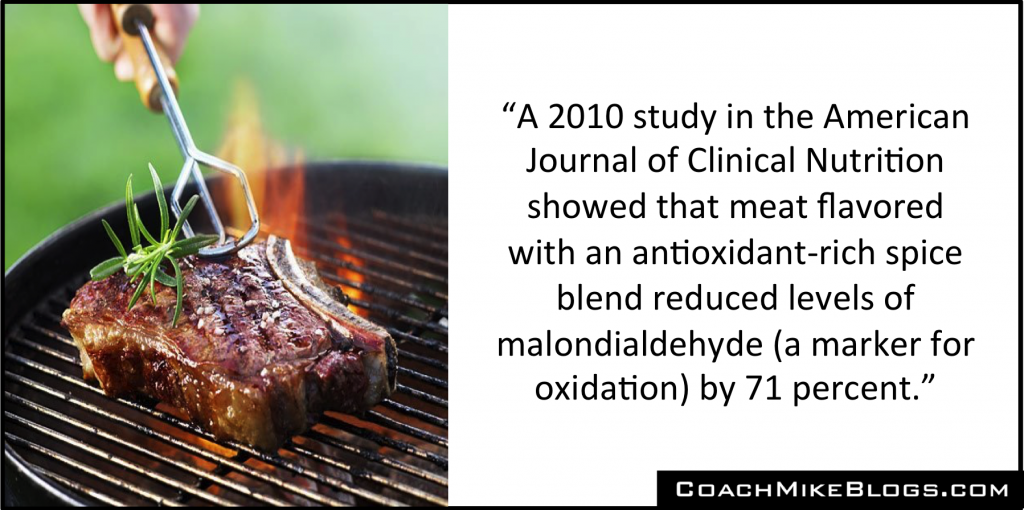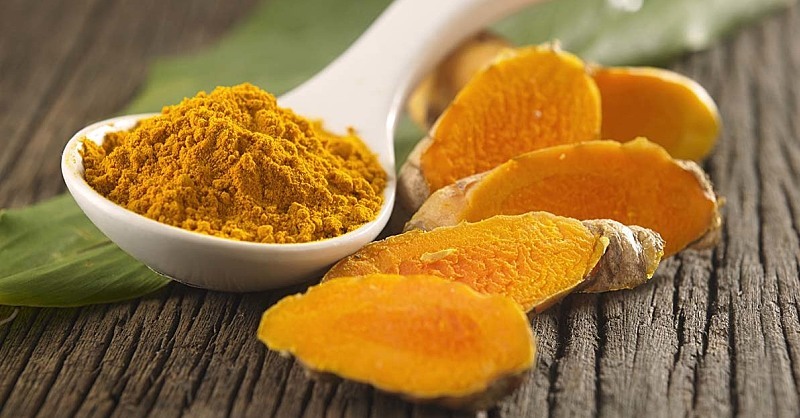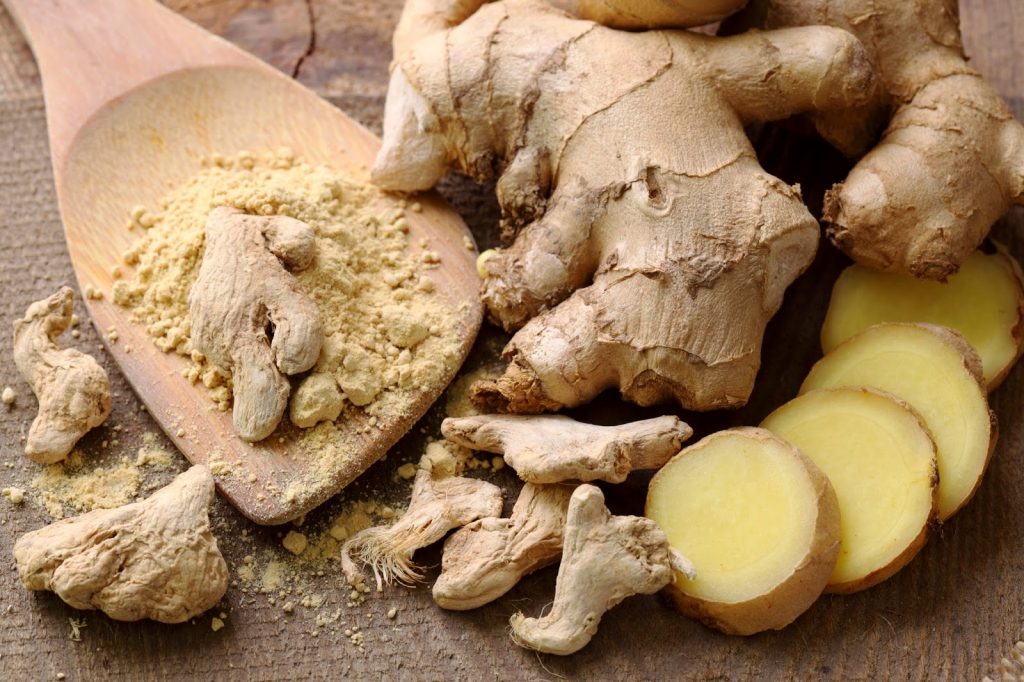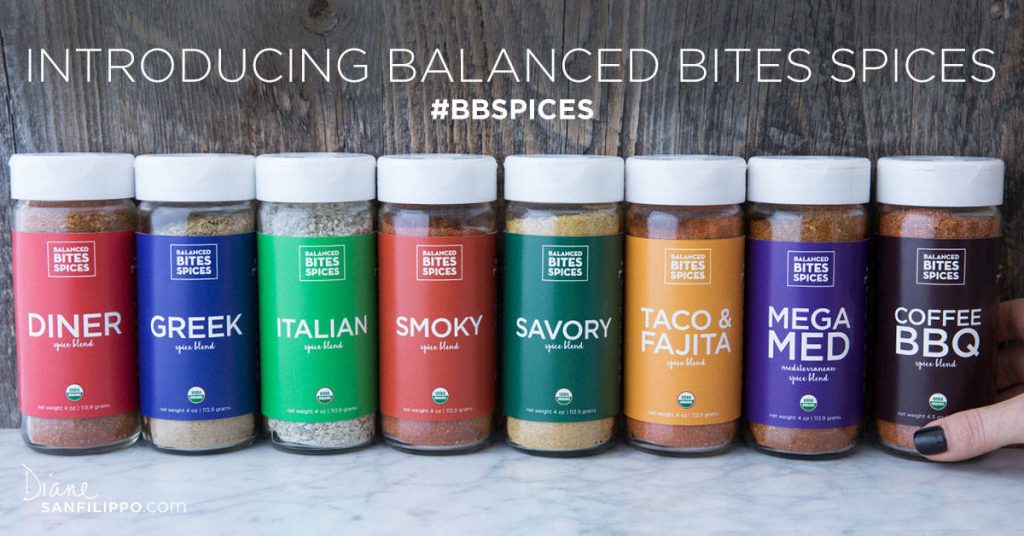As previously discussed, herbs and spices are some of the most nutritious foods. With most nutrient density scales and indexes placing them at (or near) the top of the chart – just under organ meats. And many of them providing FAR MORE antioxidants than fruits and vegetables – on a per-weight, or gram-per-gram basis.
- The phenol levels in cloves are 30% of dry weight, compared to 5% in blueberries.
- Oregano has 42 times more antioxidant activity than apples (1tbsp = 1 medium sized apple).
Meaning those not making an effort to consume herbs and spices on the regular are missing out on the opportunity to pack their meals with nutrients (and taste), and protect themselves from disease and degeneration.

For the sake of sanity (and attention span), we won’t review the health benefits of each spice individually, or the research surrounding direct disease treatment (ex: cancer), but we will touch on the top 10 performers, and the impact they can have on some critical biomarkers. Which hopefully provides enough persuasion for you to make room in your cupboards, prioritize them in your diet, and include them in your cooking.
(Note: Top 10 Herbs Discussed Here)
1. Turmeric
Curcumin is the main health boosting ingredient in turmeric, and turmeric forms the foundation of curry. It’s biggest benefit is that it reduces inflammation (1, 2, 3), and thus helps reduce the risk of pretty much every degenerative condition. Especially those of the brain, and heart (1, 2).
For instance, there’s evidence to suggest that lower rates of Alzheimer’s disease in India (compared to the U.S.) and East Asia (compared to Europe) may be partly related to greater amounts of turmeric consumption.
Like most of the other herbs and spices, curcumin is also a powerful antioxidant; meaning it provides dual protection against disease. With research showing that it’s 5-10 times stronger than vitamin C and E when it comes to gobbling up free radicals (1, 2, 3, 4, 5)

2. Cinnamon
When you think of cinnamon, you need to think “blood sugar.” Not only because it’s a sweet flavored spice that’s a great replacement for sugar, but because it’s one of the best things you can add to your daily regimen to improve your insulin sensitivity and glycemic control (1, 2, 3, 4, 5).
For instance, a 2009 review study from the journal Diabetes Obesity and Metabolism looked at cinnamon’s affect on fasting blood glucose in type 2 diabetics and found reductions ranging from 10-29%.
As discussed here, the easiest way to add cinnamon to your diet is to put it in your coffee or tea. Since this is already a consistent ritual for people that will easily put them in the 1-3 gram per day range (1-2 teaspoons) where these benefits lie (1, 2, 3). However, it’s also a great spice for adding to other foods. With the pan fried nuts discussed here, or some of the “Good Starches” discussed here (like apples and sweet potatoes) being incredibly tasty, almost dessert-like options.
3. Garlic
Other than making meals taste delicious, garlic needs to be in your spice cabinet (or in your pantry as a bulb) because it’s an insurance policy. Protecting you against the common cold and other sicknesses (1, 2), and enhancing the overall health of your gastrointestinal tract – where disease starts.
Basically, a regular dose of garlic keeps things balanced in your gut. By killing yeast and pathogenic bacteria (1, 2, 3), and feeding the beneficial microbes that help keep us lean and healthy.
Interestingly, the other members of the allium family (onions and shallots) do the same, but what sets garlic apart is it’s allicin content. And since this organic compound is only released when the garlic cloves are chopped or crushed, it should serve as a nice kick-in-the-butt to consume it fresh when possible.
4. Cayenne/Paprika (Peppers)
This spice comes from those little red and green, (sometimes hot) peppers, so as expected it’s best known for it’s ability to fire up your metabolism and get your blood pumping. With it’s high capsaicin content being responsible for the bump in energy expenditure and dilation of blood vessels.
Although, the real benefit from these capsaicin containing spices is their ability to control hunger. And arguably, this is the bigger driver behind all the positive research on fat loss (1, 2, 3, 4, 5, 6, 7, 8).
For instance, a 2011 study from the journal Physiology & Behavior split 25 normal weight men and women into 2 groups – 1 receiving 1 gram of red pepper spice, and the other receiving none. Finding that the spice eaters had a slightly higher core temperature and energy expenditure, and a significantly lower appetite and desire to consume fatty, salty, and sweet foods.
And similarly, a 2009 study in the European Journal of Nutrition noted no difference in energy expenditure, but a significant difference in ghrelin (the hunger hormone), after assigning participants to a capsaicin-containing, or capsaicin-free lunch.
5. Ginger
Similar to turmeric, ginger is best known for it’s anti-inflammatory effects. Though it’s more closely related to garlic, in that it’s benefits lie in the gut. Helping soothe or calm the muscles of the gastrointestinal system and serving as a remedy for nausea and morning sickness (1, 2, 3, 4, 5, 6).
There’s also plenty of research to suggest that ginger is beneficial for arthritic pain and muscle soreness (1, 2, 3, 4), which wouldn’t be surprising given it’s anti-inflammatory effects.

Like the other herbs and spices, it’s also a plant that supplies a hefty dose of antioxidants, so you can expect to experience the same protection against disease. Most notably, those of the brain and heart.
6. Cloves
When looking at the more common herbs and spices listed here, ground cloves actually have the highest ORAC value – a measure of antioxidant status. With some indexes suggesting that’s it’s nearly double that of oregano, the next highest gram-for-gram.
Now, obviously, this should be enough reason to include cloves in your cooking. But the motivation to include it grows in significance when you realize what it does for your digestion. Essentially “warming up the stomach,” and encouraging the body to secrete hydrochloric acid (HCL), which is critical for the proper breakdown of food and absorption of nutrients in it.
(image)
In fact, a lack of HCL (stomach acid) is one of the reason many are struggling with heartburn, indigestion, and other gastrointestinal issues. As despite the conventional advice to reduce stomach acid with harmful antacids, this simply make things worse.
7. Cumin
Often confused with a similar spice called caraway, cumin is another popular ingredient in curry, and is responsible for that delicious taco flavor in Mexican dishes. Like the other spices, it has a long list of medicinal uses and natural remedies, but it’s best to think of it as a digestion helper, bacteria fighter, and oxidation preventer (1, 2).
Interestingly, there’s also quite a bit of evidence to suggest that cumin may reduce blood glucose, and glycation (in diabetic rats), and boost the immune response (in stress-induced mice).
Which would be fantastic, but we’ll take with a grain of salt. As realistically, we should be consuming cumin anyways – for the taste!
8. Cardamom
There’s only one thing to remember with cardamom, and that’s Chai Tea. With this sweet-tasting spice providing that vanilla flavour that some people love, along with some tremendous health benefits that most people are unaware of.
For instance, cardamom is one of the top spices for aiding digestion, it’s powerful oil kills pathogenic bacteria (Streptococcus mutans and Candida albicans) in the mouth (and likely the gut), and it has a similar dilating affect – supporting better oxygen and blood flow.
Other than using it in tea, or to add some sweet to your dishes, you can try chewing on the cardamom pods (like they do in India) to fight bad breath and get a little teeth cleaning (from the fibrous coating).

9. Fennel seeds
Another sweet flavored, cooling spice that helps with digestion and bad breath, fennel is an underutilized plant with antioxidant rich seeds you should be consuming.
Similar to the other gut-supporting spices, the essential oils in fennel seeds appear to stave off infection and relax the stomach muscles. Providing relief to those with a stressed-out, irritated gastrointestinal tract, and protection against bacterial overgrowth and infection (1, 2).
Fennel is also a rich source of antioxidants. With one analysis, published in 2009 in the Flavour and Fragrance Journal, indentifying 23 bioflavoid or phenolic-rich compounds in the essential oil produced from it’s crushed seeds.
10. Peppercorns (Black Pepper)
The most commonly traded and consumed spice, yet the benefits of pepper are commonly unknown. Because if they were known, we’d see more pairing of pepper with other spices; given that “increasing the absorption of other nutrients” is it’s biggest attribute.
For instance, in a 1998 paper in the journal Planta Medica, researchers administered 2g of curcumin with and without piperine (the chemical compound in peppercorns), and saw 2000% greater bioavailability when piperine was included.
Similar to the capsaicin in chilli peppers, piperine provides the spiciness that comes with peppercorns. Though, it’s nowhere near the heat (at roughly 1%) and thus nowhere near the metabolic boost potential.
Honourable Mentions
- Caraway
- Saffron
- Anise,
- Mustard Seeds
- Allspice (Jamaican Pepper)
- Fenugreek
Stay Lean!
Coach Mike
P. S. I recommend making your own herb and spice blends as opposed to buying pre-mixed varieties (click here for my 13 DIY recipes). However, if I was to recommend one brand of pre-mixes, it would be this one from Balanced Bites...
RELATED ARTICLES:
The Truth About Salt & Hypertension
Herbs And Spices - My Top 10 Herbs For Health

